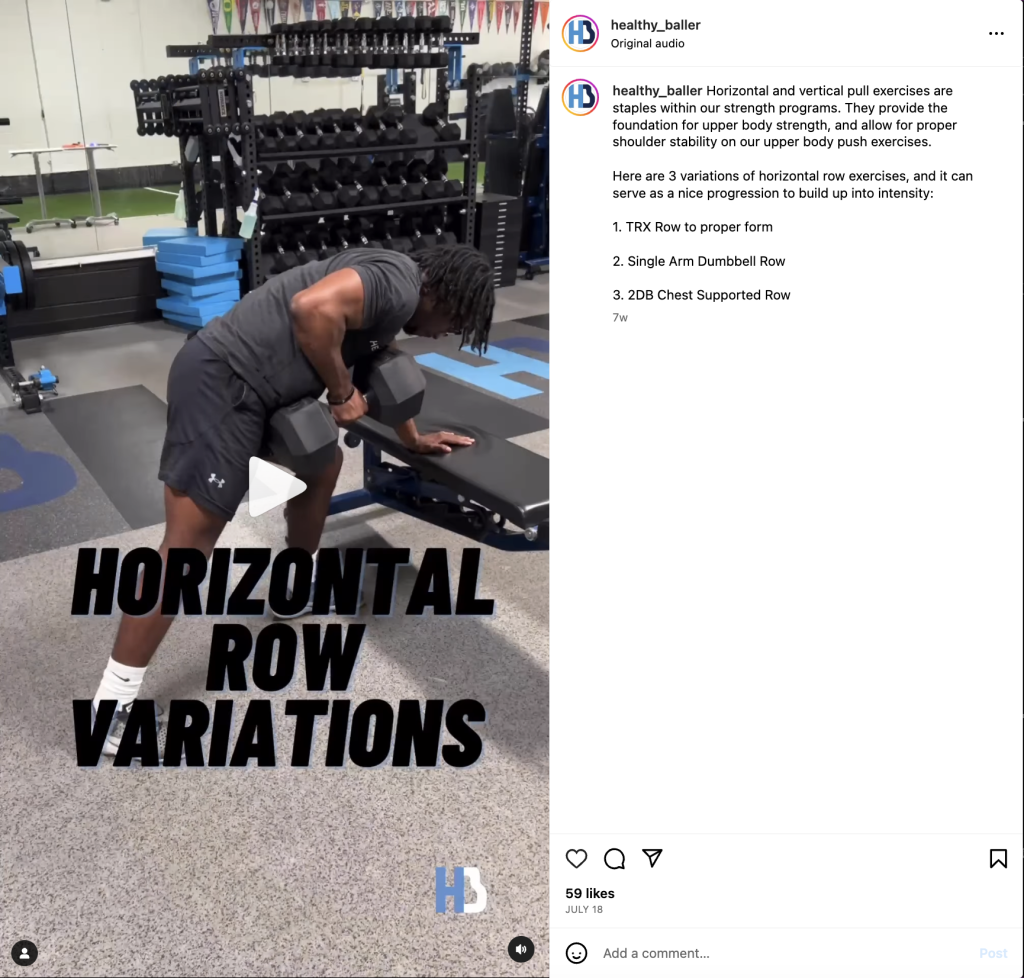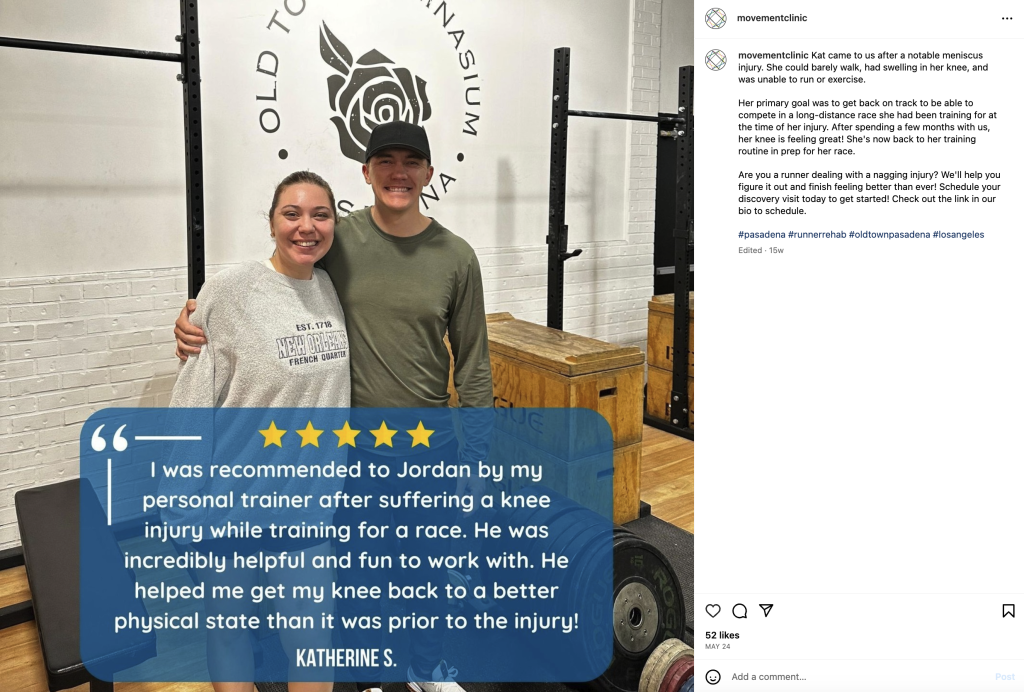
Everything You Need To Build a Clinic Marketing Strategy
Practice ManagementWhether you’re opening a new practice or looking to breathe new life into a longstanding clinic, these marketing activities will get you to your goals. Learn how to create a clinic marketing strategy that includes content marketing, digital ads, local SEO, trackable KPIs and more.
In the fast-paced world of clinic marketing, practice owners and managers have a unique set of challenges and opportunities. Whether physical therapy, occupational therapy, sports medicine, or chiropractic, your clinic needs to stand out in the crowd and connect with patients. Marketing campaigns that resonate in a genuine way will strengthen your patient relationships and help grow your clinic.
This guide will take you through the many elements of successful clinic marketing with actionable steps to thrive in today’s healthcare market. Here’s what we’ll cover:
- How to identify your audience
- How to set your clinic marketing goals
- Tailor your message
- Word of mouth marketing for clinics
- Building customer relationships
- Measuring patient satisfaction
- Testimonials
- Dealing with negative reviews
- Digital marketing for your clinic
- Web development
- Local SEO
- Blogging
- Social media engagement
- Content marketing for your clinic
- How to develop a content marketing plan
- Types of content marketing for clinical settings
- Build patient relationships with content marketing
- Paid ads
- Paid search engine marketing (SEM)
- Paid social ads
- Local community engagement
- Volunteer opportunities
- School and local sports teams
- Workshops
- Analytics and performance tracking
- Website analytics
- Social media analytics
- Email engagement analytics
- Paid advertising analytics
Identify Your Audience
Understanding the target audience is the foundation of every effective clinic marketing strategy. The more specific, the better. It’s not just “people who live here and need these services.” It’s also factors like age, income, occupation, interests, communication preferences, where they seek information, even how they think about healthcare. Some of this information you can find online, some of it you will learn by experience. The bottom line is – by identifying key demographic and lifestyle factors of your potential clients, you can tailor your messaging to resonate with them more effectively.
Set Your Clinic Marketing Goals
Setting clear and measurable goals is crucial to tracking the success of your marketing efforts. Common goals for outpatient therapy clinics include improving retention, reaching a particular population, building online presence, and diversifying referral sources. Many are familiar with SMART goals, meaning Specific, Measurable, Achievable, Relevant, and Time-bound. This is a great way to put your vision into a concrete, actionable plan.
Tailor Your Message
This is where your background preparation will take shape. The more specifically you defined your target audience and goals, the stronger your message will be. Crafting a compelling and relevant message is key to capturing the attention of your audience. Develop messaging that highlights your clinic’s strengths and services and how you can help clients achieve their goals. Instilling a sense of knowledge and confidence will encourage potential clients to choose your clinic.
Word of Mouth Marketing
Did you know that 92% of people trust recommendations from people they know1? Word of mouth is a huge part of clinic marketing success. This includes building relationships with your current clients, seeking feedback, and generating testimonials. More on each of those next.
Customer Relationships
Establishing strong relationships with your clients is the cornerstone of word-of-mouth marketing. Excellent customer service and personalized care will create a positive patient experience. In turn, satisfied patients are more likely to recommend your clinic to others. If client referrals aren’t a strong source of referrals for your clinic, check out this article for help with expanding your patient base: Clinic Marketing: You’re Doing it Wrong.
Measure Satisfaction and Get Feedback
The best way to improve your patient relationships is to start by measuring your current status. Measuring your clinic’s Net Promotor Score tells you two important pieces of information. First, it indicates current customers’ satisfaction levels. Second, it can project your future growth as a business.
As a bonus, some customers may also take this opportunity to give you feedback on what was helpful and what needs to be improved. Customer surveys like the NPS provide valuable perspective that you and your staff might not realize if you don’t ask. Learn more about how to use the Net Promotor Score for your clinic here: Gauging Your Clinic’s Growth Potential by Asking One Simple Question
Testimonials
A staggering 68% of word-of-mouth referral patients say online reviews were the top reason for their provider selection2. Given how much people rely on online reviews, this is a marketing tactic you should take advantage of. The best thing you can do is make it easy for clients to leave you glowing reviews online. Some clinics use a QR code in the lobby or email links to their Google profile for reviews. Plus, you can share these online reviews on your social channels for added positive exposure.
For more guidance, read this article: How To Use Customer Testimonials To Fuel Your Clinic’s Business. Physical therapy, occupational therapy, sports medicine, and chiropractic clinics can attract new patients by showcasing testimonials from past successes
Dealing with Negative Reviews
On the other hand, you may get the occasional negative review. The best way to handle negative reviews online is to respond quickly, hear them out, and address the issue. You can respond directly to the comment online, apologize for the sub-par experience, and invite them to email or call you directly for a resolution. Moving the conversation to email or phone helps prevent it from escalating in a public forum and lets you get more details on their experience. Negative reviews are almost inevitable, but you can use them to repair and strengthen your customer relationships.
Digital Marketing for Clinics
Building your clinic’s online presence is crucial for success. Leveraging multiple digital channels will help you broaden your reach, build relationships, provide valuable healthcare information, and grow your clinic. In this section, we’ll explore several elements of digital marketing for clinics, including web development, local SEO, blogging, email marketing, social media, and content marketing.
Web Development
Your website often provides the first impression to people seeking information about your clinic. A professional and easy-to-use website should accomplish the following:
- Showcase your services
- Highlight the expertise of your staff
- Show patient success stories
- Provide educational content, such as articles and videos
- Allow online booking
Creating and maintaining a quality website does require time and skill. Depending on your goals, you may be able to accomplish this in-house with user-friendly builders like WordPress. However, many small businesses prefer to hire contractors for web development. Professional web developers can create higher-quality sites with advanced capabilities that enhance the overall user experience. This route can save you time and ultimately help grow your clinic.
Local Search Engine Optimization (SEO)
When people search for therapyservices in your area, you want to be one of the first options Google serves up. Search engine optimization (SEO) is the ongoing process of developing your website to do just that. SEO involves several elements that work together over time to boost your rankings. If you’re new to SEO, here are a few simple improvements to get you started:
- Keyword research – Make a list of terms and phrases that you want to rank for, and tailor your web content around those terms
- Meta descriptions – Each page of your website should have a meta description and headings that clearly describe what the page is about and incorporate your keywords assigned to that page
- Test the site / page speed – Use Google’s page speed test to see your website’s performance. The faster your load time, the better. The report includes specific recommendations to improve your speed.
SEO is a topic that deserves its own article, and even its own blog! The world of local SEO is vast, with seemingly endless tips, strategies, and updates (to keep up with ongoing algorithm changes). If you don’t want to tackle this yourself, it’s a good idea to check with a freelance SEO specialist or agency. Outsourcing can save you time and stress, produce better results, and have a positive ROI. Pro tip – most SEO professionals also have the skillset or network to help with your other digital marketing efforts. Finding a freelancer or agency with a broad marketing skillset gives you more benefit for your investment.
Blogging
Blogging is one of the biggest contributors to SEO. Keyphrase-rich articles are an excellent opportunity to educate patients and drive web traffic. Post articles regularly that address common patient concerns, specific diagnoses, treatment techniques, exercise and wellness tips, and other relevant topics.
Producing this content online not only provides helpful info for patients, but it is a strong signal to search engines that your website is a trustworthy source of information. Take it a step further by inviting readers to subscribe to your blog. With a subscription, your audience can stay up-to-date on the latest posts and clinic announcements. Starting a subscriber list via your blog opens another opportunity for email marketing.
Direct Patient Communication Through Email
You likely already use email for appointment reminders, scheduling, billing, etc., but it’s worth noting here. Email marketing can keep your patients informed about clinic updates, promotions, and healthcare tips. Regular communication helps foster patient relationships and encourages return appointments.
Email marketing platforms like Mailchimp, HubSpot, and Constant Contact can save you time with templates and automated sending. The list of available email platforms, even those that specialize in healthcare, is extensive. Most offer a free version with optional paid upgrades. It will take some research to find the right email platform for your clinic. When browsing, here are the important criteria to look for:
- Number of allowed contacts
- Number of email sends per month
- HTML email templates
- Automated workflows – For example, the ability to automatically send a confirmation email when someone submits a contact form on your website.
- Contact list creation and customization
- Contact profile tagging
Social Media Engagement
We’re well past the days of questioning whether a clinic needs social media. As 41% of people use social media to choose a healthcare provider, the value to your clinic is clearNow it’s a matter of how to engage followers and grow your account.
You don’t have to be an influencer to drive business with social media. But if you’re curious about how influencer accounts build a loyal and engaged audience, read What The Influencers Got Right: Social Media Marketing in Rehab
For most clinics, it’s enough to follow these three best practices: post regularly, create visually engaging content, and interact with the community. Posting frequency isn’t an exact science, but you should aim for at least once per week. Save time by creating a batch of short, simple posts all at once and scheduling them in advance.
Most clinics grow their engagement by posting exercise and wellness tips. Here are a few example posts from clinics with very strong social media following:



Remember, social media engagement is a two-way street. Interact with similar accounts to reach new followers and show your expertise. Accounts like @ThePrehabGuys, @ThePhysioFix, and@OT.4.Lyfe provide an online community for physical therapy, occupational therapy, and other rehab-related content.Explore any of these accounts to see how they leverage content for multiple platforms to grow strong online engagement.
Content Marketing for Your Clinic
Under the umbrella of digital marketing, content marketing is an information-driven strategy. The clinic provides valuable and relevant information, establishing itself as a trusted authority on certain topics. This credibility extends to both patients and search engines, as digital content engagement provides a huge SEO boost. Content marketing is an opportunity to connect with your audience and ultimately create stronger patient relationships and clinic growth.
How To Develop a Content Marketing Plan
Before writing your first blog post, it’s crucial to develop a plan. This plan will serve as a roadmap, guiding your efforts and ensuring that they align with your clinic’s goals. Many of the same general marketing principles apply to content marketing:
- Define your goals – Common goals include increasing retention, attracting a specific type of patient demographic, building your online presence, diversifying referral sources, etc.
- Identify your target audience – Consider factors such as age, gender, location, occupation, interests, pain points, and healthcare preferences.
- Research – Explore the content that’s already available online. Look at your competitors, i.e. other clinics or publishers of similar content. Pay attention to what formats are the most effective, whether blog posts, social media videos, infographics, etc.
- Develop content topics –Brainstorm a list of topics and themes that align with your clinic’s expertise and your audience’s interests. You may also seek input from your clinical staff.
- Publishing schedule – Consistency is key in content marketing. Create a publishing schedule that is reasonable given your resources and ensures a steady flow of fresh material.
Types of Content Marketing for Clinical Settings
The format of your content is just as important as the topic. For the most part, the format will be dictated by the complexity of topic itself and your available resources. The most popular formats are blog posts, videos, and e-books.
Blog posts are a versatile tool for providing articles on specific conditions, patient concerns, treatment techniques, and other relevant topics. Videos are a highly engaging way to demonstrate exercises, showcase success stories, or do a live Q&A with your clinic staff. E-books are a long-format resource that can delve deep into specific healthcare topics. E-books should be thoroughly researched and carefully planned. Offering free e-books on your website in exchange for contact information is a great way to drive engagement and build your email list.
How To Build Patient Relationships with Content Marketing
Your content should be driven by patients’ questions and concerns. By addressing these issues proactively, you can establish your clinic as a trusted resource. Here are a few ideas to spark your content creation:
- Patient education – Create articles, videos, or e-books about certain conditions, treatment techniques, and recovery processes. Blog posts are a great format for explaining common diagnoses and treatment approaches.
- FAQs – With input from your staff, create a list of frequently asked questions. Create a blog article or web page that provides detailed answers in a Q and A format. This helps patients find information easily and positions your clinic as a reliable source of information.
- Success stories – Include your testimonials in your content marketing. With permission, share success stories from patients who have benefited from your services. Real-life examples demonstrate your expertise and instill confidence in potential patients.
- Prevention and wellness – Offer content on preventive measures and general wellness. Content about a healthy lifestyle can attract a broader audience.
Paid Advertising for Clinics
No discussion of clinic marketing strategy is complete without considering paid advertising. While word-of-mouth and digital marketing can get you far, paid ads can put you farther ahead. Advertising allows you to reach a larger and more targeted audience, driving website traffic, patient inquiries, and appointment bookings. Up next, we’ll explore two options for paid ads: search engine and social media.
Paid Search Engine Marketing (SEM)
Paid SEM places your advertisements at the top of Google’s results page. Of course, there are many search engines, but for our purposes, we will stick to Google Ads (frequently referred to by its former name, AdWords). Search ads allow you to reach a broader audience of qualified individuals – such as someone in your clinic’s zipcode searching for knee pain tips.
With Google’s advertising platform, you are in control. Choose the keywords and phrases you want to target, dial in to audience demographics, and set a monthly maximum budget. It also provides suggested headlines and copy to help populate your writing. Most importantly, Google Ads provides extensive performance metrics. This reporting allows you to track key metrics like clicks, impressions, cost-per-click, and more.
Paid Social Media Ads
Social media ads promote your clinic by getting your chosen post in front of more qualified people. Like SEM, social media ads have the benefit of a wider reach to a targeted audience. Engaging posts encourage likes, clicks, shares, and follows. Depending on your campaign setup, you may even complete appointment bookings directly through the platform.
The most effective social ads are highly visually engaging. Use video, bold images, and carousel ads to showcase your clinic’s facility, staff, success stories, and more. Social media ads allow you to set and adjust your budget to a level that works for your clinic.
Expand Your Geographic Reach
You have probably found that most of your client base is local, living within a few square-mile radius of your facility. Clinics that want to expand that geographic reach can do so by providing engaging, technology-driven rehab. Patients will travel farther to get a unique, interactive therapy experience they can’t get anywhere else. Take a look at this case study where Vereen Rehabilitation expanded their geographic reach thanks to a one-of-a-kind treatment experience.
Local Community Engagement
For immediate impact, however, maximizing the volume of clients you draw from your local community is a great place to start. This is your most fertile field for bringing in new patients. Picking the best channels for promoting your local presence will depend on the demographics and socioeconomics of your community, and on the clinical offerings you want to promote. There is no one-size-fits-all formula, but let’s explore a few of the best tried-and-true tactics many successful clinics are employing.
Volunteer Opportunities
Volunteering your services in the local community is one of the most powerful tools to increase visibility and drive more business. While it may seem paradoxical, offering free services can yield a significant payoff in new patient acquisition. Participating in local community events increases brand visibility, creates valuable personal interactions, reaches people who otherwise may never have heard of your clinic, and as a bonus, presents an opportunity for social media engagement. Read on for three ways to engage your local community.
Fitness Events and School Sports
Increasingly, growth-minded clinics are getting involved in local fitness events, such as races and obstacle course events. Onsite services such as stretching or recovery a great way to develop new patient relationships. Some clinics even go so far as to offer recurring workshops to local schools and athletic teams to establish a relationship and to drive clinic visits down the road.
Community Fairs
Getting involved in non-sports-related events is an oft overlooked opportunity to generate good engagement. Outdoor concerts, holiday festivals, and other fairs offer booth spaces for local businesses. Take advantage of the opportunity to establish local visibility and connect with prospective patients. Your booth can offer basic screening, feedback on musculoskeletal ailments, massage, and information on how your clinic can help their condition.
Condition-specific Workshops
Broad visibility is great, but sometimes you may want to promote your services in a more directly focused manner. Offering workshops specific to certain conditions and treatments is a great way to attract individuals who need your help. Whether you host them at your clinic or a community center, you create the opportunity to engage prospective patients and clearly showcase your clinic’s expertise.
Key Performance Indicators for Clinic Marketing
At BTE, we’re all about tracking performance. Of course, we focus on measuring patient progress with objective clinical tools, but the same goes for clinic marketing. Your digital footprint can become your biggest driver for patient acquisition. But how do you know how effective your website and marketing efforts are? Just like in occupational therapy, physical therapy, athletic training, and chiropractic practice – you need objective measurement to inform your decision-making. Otherwise, you’re just guessing.
The beauty of digital marketing is that it’s all measurable, so you get clear feedback on performance. Whether you want to track website traffic, online form submissions, email opens, views and clicks on your ads, incoming calls, or other marketing KPIs, you can measure it all digitally. These reports will tell you whether your efforts are working, or whether your strategy could use help from an outside marketing specialist.
Website Analytics
Starting with your website performance, Google Analytics is the most robust tool available and it’s free. Google Analytics can get as detailed as you need. You can measure monthly visitors, total pageviews, what pages (or content) draw the most visitors, time on page, traffic source such as social media or search engine, and more.
Chances are, your web designer already set your site up with Google Analytics. In that case, just log in to your account to see your stats and start monitoring progress. If you don’t already have Google Analytics, all you have to do is sign up online with a Gmail account. Then, ask your web designer to simply integrate the analytics code into your website to start collecting data. The entire process should only take minutes. Because Google Analytics offers so much data, you may need support in figuring out how to find what you need. Thankfully, there are a plethora of educational videos online to help you learn the platform.
Additionally, Google Analytics experts are easy to locate as well if you find that you could benefit from some outside help to manage the traffic reporting and make sense of the numbers. For a small investment, you could generate some good returns. Often, Google Analytics experts will also be adept at Search Engine Optimization (mentioned earlier in this piece), so you can benefit from the convenience and cost savings of having the same resource help you in both areas.
Email Marketing Analytics
Other marketing channels like email, social media, and paid advertisements have their own KPIs and systems of measurement. One of the most important benefits of an email management platform like MailChimp is the performance insight. These platforms will report valuable stats like opens (an indicator of subject line quality), clicks (indicator of content quality), spam reports, and more.
Social Media Analytics
Social media analytics are best measured in a third-party platform like Hootsuite. That’s because they will report metrics like followers, impressions, and clicks across all your accounts in one convenient dashboard. These reports combined with the scheduling capability make social media management software a valuable part of your clinic marketing.
Paid Advertisement Analytics
Your paid advertisements have analytics built in. The stats available depend on the structure of your campaign. Basic metrics like impressions (the number of times your ad was shown to a user), clicks, and cost per click are simple ways to track your campaign. More detailed metrics require some research and strategizing to optimize your ad dollars
For example, cost of acquisition tells you the cost of an ad that someone viewed, clicked, and acted on to book an appointment and become a new patient. This metric would require integration with your website analytics or contact management software for a complete picture. You could use this metric to determine whether you need to dial up or down your budget on a certain campaign, and compare digital ads to other marketing efforts in terms of new patient acquisition.
Again, this may be something you want to delegate to a digital marketing specialist. Setting up your advertising and marketing analytics up front will set you up for success in achieving your goals. You’ll learn what works and what doesn’t, where you should cut back or increase spending, which tactics work best for your marketing goals, and how people interact with your clinic online. You’ll never have to wonder, is my marketing working?
Conclusion
As you have seen here, a well-planned clinic marketing strategy can help your physical therapy, occupational therapy, sports medicine, or chiropractic practice thrive. Whether you’re opening a new practice or looking to breathe new life into a longstanding clinic, engaging in these marketing activities will get you to your goals. Understanding your audience, setting clear goals, and tailoring your message are foundational to successful clinic marketing. Nurturing word-of-mouth marketing and cultivating customer relationships will help you establish trust within the community.
Digital marketing spans website development, SEO, blogging, email and social media to create a strong online presence for your clinic. Augment your efforts with content marketing that builds mutually beneficial relationships between your clinic and potential patients. Paid advertising channels like SEM and social media expand your reach even further. Local community engagement creates positive interactions and local recognition of your clinic. Throughout the process, analytics reports will inform your decision making. Clinic marketing strategies that blend tradition with innovation will help your clinic thrive, ensuring a prosperous future in the ever-evolving healthcare landscape.
If you found this article helpful, explore our other articles on clinic marketing, practice management, treatment tips, clinical research, and more. Subscribe to TherapySpark to get monthly updates on all things rehab.
References
- Nielsen. (2012). Global Trust in Advertising and Brand Messages. https://www.nielsen.com/insights/2012/global-trust-in-advertising-and-brand-messages-2/
- Pew Research Center. (2011). Online Search Summary Charts. https://www.pewresearch.org/internet/2011/02/01/summary-charts/
- Brevo. How to Use Email Automation Software for Marketing. https://www.brevo.com/blog/email-automation-software/
- Search Engine Watch (2012). 33% of US Consumers Use Social Media for Health CareInfo (Survey). https://www.searchenginewatch.com/2012/04/22/33-of-u-s-consumers-use-social-media-for-health-care-info-survey/





